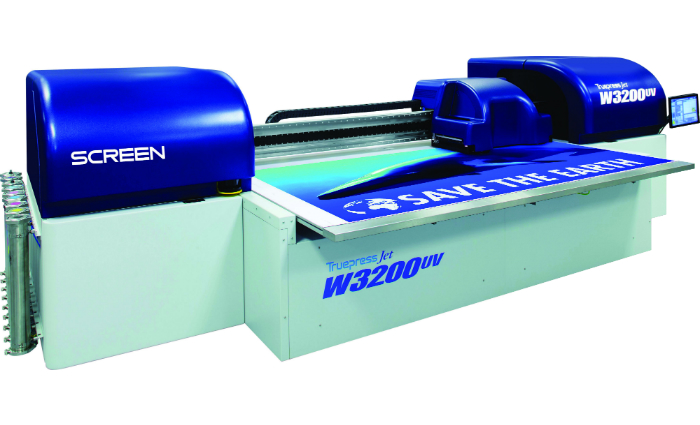
What does it do?
Claimed to be the fastest in its class, the W3200UV is a large format, high-throughput and high resolution UV flatbed printer with a high-opacity white ink option. It can take rigid board or paper sheets up to 3.2 x 1.6m format and up to 50mm thick, or multiple smaller sheets at once.
When was it launched and what market is it aimed at?
Screen showed the Truepress Jet W3200UV at Fespa last June. It is largely aimed at industrial printers who want to print directly on display panels and the like, including foam, metal-foam sandwiches and plastics.
The printer is built by Inca Digital and sold and supported by Screen, which owns Inca. Fujifilm has marketing rights to earlier Inca printers, and showed a ‘technology demonstrator’ of the same machine, called Avoset, at Fespa. But it seems it does not currently plan to bring it to market.
How does it work?
The W3200UV is a travelling bed printer, where the bed moves under the head carriage gantry, which builds up the image with 10, 14, 18 or 22 passes, depending on the speed and quality required. The top model has eight ink channels for CMYK, light cyan, light magenta and two white inks.
It prints 14-picolitre drop sizes with a thin-film UV-cured ink designed with flexibility in mind. Built-in automatic cleaning features mean the printer is ready to use more quickly in the mornings than older designs.
Sheet loading and unloading is manual, with retracting registration pins for easy positioning and a multi-zone vacuum bed for different sheet sizes, or printing more than one sheet at once. A mechanical sensor detects unevenness and will stop the linear motor immediately to prevent head crashes.
Work on acrylic sheets may experience static build-up problems which can be eliminated by installed a third-party overhead neutralising bar.
What’s the front-end?
A number of rip and workflow front-ends can be used, but Screen particularly recommends the Caldera rip, which it says is fast and easy to operate. Operators can set defaults and click and drag to make up layouts. It can go to print with a job in as little as ten seconds. Screen can also provide modules from its Equios workflow automation suite, such as PDF Polisher and font checking.
How does it differ from previous models?
It is a brand new model, not part of Inca’s Onset and Spyder families. This is the first Inca Digital Printer with a white ink.
How fast/productive is it?
Screen says a ‘realistic production speed’ is 85sqm/hr. For top quality with maximum passes, early users say they rarely drop below 66sqm/hr, and 40sqm/hr with white.
What is the USP?
Mainly the ability to achieve high quality images at ‘realistic’ production speeds. Features like the mechanical unevenness detector and self-cleaning start-up routine are also unusual and useful.
How easy is it to use?
Screen says after initial training it is straightforward. The self-cleaning feature will particularly appeal.
What training and support is on offer?
The price includes a full training and service package, according to Screen Peter Scott, through Screen’s extensive network of service engineers.
The alternatives
DURST RHO P10 200 Durst specialises in high-end inkjets. This one has almost entry level pricing for Durst. It is wider than the W3200UV and the belt feed makes for unlimited lengths with continuous feeding, no taping. There is also a roll feeder.
Max media width: 2m
Max media thickness: 40mm
Speed: Up to 200sqm/hr (100sqm/hr production quality, 65sqm/hr photo quality)
Colours: CMYK standard, with light cyan, light magenta, orange, green, violet and clear options
Printheads: Durst Quadro 10 array technology, 10-picolitre drops
Max resolution: 1,000dpi
EFI VUTEK QS3 PRO Similar in speed and price to the Screen, this is a hybrid UV inkjet for rolls and rigid sheets. Its belt transport does not need taping.
Max media width: 3.2m
Max media thickness: 50.8mm
Speed: About 70sqm/hr at 600dpi and about 45sqm/hr at 1,000dpi
Colours: Six colours plus white, with three-layer white sandwich capability
Printheads: Greyscale with 0-36 picolitre drop sizes
Resolution: 600dpi, 1,000dpi or greyscale
Comment below to have your say on this story.
If you have a news story or tip-off, get in touch at editorial@sprinter.com.au.
Sign up to the Sprinter newsletter
